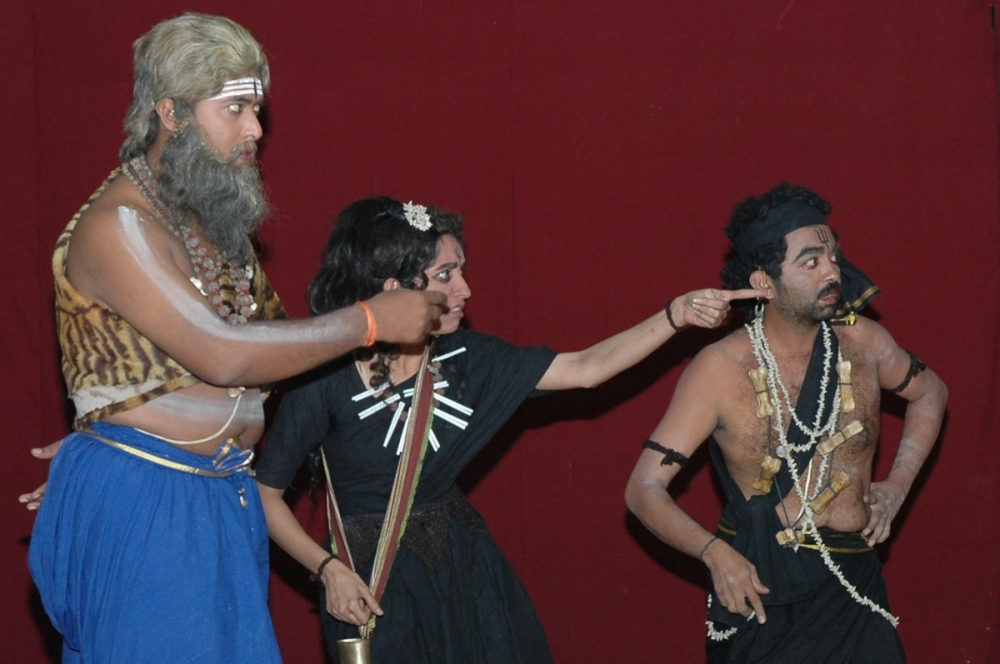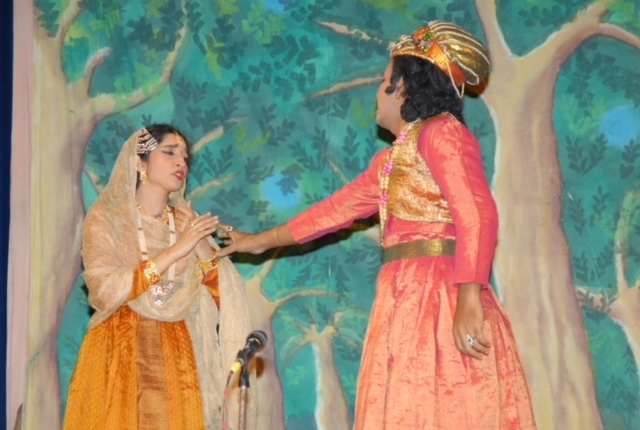The Samskrita Ranga was founded on 16th November 1958 by Dr V. Raghavan—a great visionary, an illustrious Sanskrit Scholar and a pioneer in Sanskrit Theatre.
One of his major aims was to promote Sanskrit language and its literature through the staging of authentic Sanskrit plays. This mission, which played a vital role in the revival and maintenance of an important part of our artistic heritage, acted as an easy means of fostering and popularising Sanskrit and its invaluable treasures. The Ranga appealed to the lovers of the stage to extend their active sympathy in this direction.

With its first production of Mālavikāgnimitram of Kalidasa in 1958 at the First All-India Kalidas Festival at Ujjain, Samskrita Ranga’s endeavours have continued in a sustained manner through the past six decades despite the varied challenges it has faced in its path of propagating the devabhasha (the language of gods), especially in Tamil Nadu. In the initial stages, the Ranga was associated with the Madras Natya Sangh (Theatre Centre, India, affiliated to the UNESCO) on constructive projects like training programs and collaborative efforts in theatre productions. The Ranga later continued its glorious work independently, under the dynamic leadership of its founder.
The period from 1958 to the end of the 1960s can be described as the golden period of Sanskrit drama in Madras (Chennai). In the cultural scenario of the period, Samskrita Ranga’s productions became landmark events with its plays staged at different venues including the Madras Music Academy, of which Dr Raghavan was an integral part. Ranga’s plays were praised, reviewed by the learned society, and received widespread appreciation from local luminaries as well as visiting scholars and intellectuals.
In the mid-60s, Dr V. Raghavan, as president of the Madras Natya Sangh, created and curated several fascinating endeavours by inviting experts from the West who conducted workshops in theoretical and practical aspects of theatre and its allied areas to train several upcoming actors and practitioners, some of whom later became well-known onstage and in the film industry of South India. This included former chief minister of Tamil Nadu, Ms J. Jayalalitha, Cho S. Ramaswamy, ‘Major’ Sundararajan, and ‘Venniraadai’ Srikanth among others.
These workshops became unique events as they covered several departments of play production like make-up, costume, lights, script etc., catering to the varied interests theatre enthusiasts. The productions that were experimental, with techniques learnt in the workshops, like Madhyama Vyāyoga, and Duta Vakyam (produced by Samskrita Ranga in association with Natya Sangh, and directed by Dr Raghavan), became instant hits. They were performed in the natural forest-like settings of the Madras Museum Campus, which served to be an ideal atmosphere, with special lighting provided by experts from Mumbai. These productions were witnessed by great theatre exponents, actors, directors and scores of theatre lovers. The plays of Samskrita Ranga staged at the All India Kalidas Festival had by then gained great reputation for its high quality. Dr Raghavan’s works were acknowledged as ‘pioneering works’ across the theatre scene in India. The actors of Samskrita Ranga have been mostly Sanskrit lovers, Sanskrit Vidvans, scholars, faculty members, and students of Sanskrit, dance and music. All the participants greatly admired the founder and assembled to take part in the productions out of their passion for the language.
Each play production involved a careful selection and sequencing of the scenes from the original plays, crafted to suit the time and the requirements of stage production. A keen choice of ragas was made to form the musical lining to each play. Rendering of specific verses of the play to highlight the situations was set. A traditional orchestra with vīṇā, vocal and mr̥daṅgaṁ formed the backbone of the musical team for the plays.
The Ranga produced over 50 minor and major plays in this structured format on stage and at the All India Radio—under the direction of Dr Raghavan who personally trained the actors in dialogue (vācika) delivery, perfect diction and voice modulation. He also enacted the scenes for the actors, to guide them into the nuances of body language (āṅgika), and movement technique (parikramä). Having had the experience of watching some of the great actors of the renowned Suguna Vilasa Sabha, coupled with his own expertise, Dr Raghavan could add a unique touch to his plays. His own performances as Kanva in the All India Radio play of Śākuntalam, along with his daughter and disciple Priyamvada, and as Upaali (Bhikshu Upaali) in Natir Puja of Tagore (translated into Sanskrit by Dr Raghavan), are memorable. Dr S.S. Janaki and Dr C.S. Sundaram, two of his prime disciples, ably assisted him not only in the rehearsals but also in taking care of stagecraft. Dr Raghavan was involved in every minute aspect of the production, from the selection of the bark-coloured costume for Sakuntala to the kapaalamalaa (garland of skulls) for the Kaapaalika character in Mālatī-Mādhava. Charudattan, the second son of the founder, who was skilful in painting and handcraft, was asked to make the kapaalamalaa using pith so that it would resemble the skull. These bark garments and the kapaalamalaa are still in use. Similarly, the making of many stage props, such as the deer wood cut-out or the lion cub of Sarvadamana in Śākuntalam, Dr Raghavan worked closely with the stage expert and gave him detailed instructions. From 1958-1978, meticulous management of every department of the play production was undertaken by Dr Raghavan, who directed his last play, Navagraha Carita of Ghanasyama, in1978.
In all the years up to 1998, the Ranga’s activities included arranging special lectures on Sanskrit and allied theatre forms, and production of its annual journal up to Volume XIII, the Golden Jubilee number. In the mid-’80s, Samskrita Ranga’s dramatic endeavours received another dimension with the setting up of a Natyasala for staging some of its plays like Śākuntalam Svapnavāsavadattam, Kundamālā and Āścaryacūḍāmaṇi, with inputs from Sri Goverdhan Panchal, a renowned stage expert. He created a stage according to Sage Bharata’s prescriptions of the Natyasala. The Ranga team conducted plays in this setting several times at different cultural venues, including the Kalidas Samaroh in Ujjain.
During the above period, both Dr S.S. Janaki and this writer were able to bring into the productions of the Ranga, talented dancers and musicians with innate acting abilities so that the Ranga’s productions could aim at using Natyadharmi (dance technique) to coincide with vācika. With dwindling support and interest in Sanskrit language, for its sustenance, especially in Tamil Nadu, Ranga had to improvise more on the elements of dance technique to draw a reasonable audience. This was possible because of the dedicated team of actors, some of whom had been part of Ranga’s activities in the past. After much struggle, the Ranga is continuing its stage plays especially during the annual festivals of Chennai; much to the delight of Sanskrit lovers, scholars, theatre artists, dancers, and students.
From the mid-80s, Ranga’s productions gained momentum with this dedicated team of actors who were proficient in the language, histrionics and fine arts. The plays presented in the Natyasala, especially Āścaryacūḍāmaṇi, received a good response. The enactment of the pseudo-Sita and Rama in this play could be depicted effectively using Natyadharmi, the words embellished with physical nuances. The scene of Lakshmana in Parnasala ankam (hermitage section) weaving out a hut for Rama and Sita, accompanied by musical rendering of the verse, and the tumultuous fight scene between pseudo-Sita (Surpanakhaa) and Lakshmana gave scope to improvise on the different gatī (rhythmical nuance) patterns. While these improvisations were attempted in a considerable measure, Ranga’s goal in giving the vācika foremost priority, in order to enlighten the sahṛdaya (connoisseur) with beauties of the dialogue, was always kept in mind. These were challenging moments that required complete involvement and consistent work by the actors in the innumerable rehearsal sessions, during which they exhibited great enthusiasm.

Mattavilāsa Prahasana, which is a famous play in the Kutiyattam tradition, was another bold attempt by Ranga where the actors, with minimal stage props, observed the Natyadharmi approach to elaborate the spoken word; be it in the description of the town of Kanchipura and its surroundings, the staggering dialogues and the walks of the drunken Kaapaalika and his friend, or the madman’s funny actions. It was a grand success and received appreciation from learned gatherings at Chennai, the Rashtriya Sanskrit Sansthan, New Delhi, and at the Central Sangeet Natak Akademi festivals. In the Kutiyattam theatre tradition, this play is conducted for several days continuously, elaborating the scenes with extraordinary delineations, physical actions, and orchestra accompanying the dialogues. Ranga’s staging of the same was viewed with mixed feelings by connoisseurs, who also realised the need for projecting the play from a different point of view to an audience in Tamil Nadu—with more focus on the dialogues accompanied by appropriate gesticulation, movements and also a time-bound presentation to suit the modern-day trend. Herein again, Ranga’s focus was on the language and literature expressed through lively visualisation and comfortable communication. Since its inception, Ranga’s focus on pronunciation, impeccable diction, and clarity in dialogue delivery of its actors has raised the status of its plays. The plays have been hailed for their high standard by many stalwarts who witnessed Ranga’s productions over the decades. It was a crucial factor in fulfilling Ranga’s aim of propagating the Sanskrit language and sustaining its continuation in a region which has been deprived of adequate support from the government.
Adding dance technique to the spoken word has been developed in a gradual process with each and every actor in the team. Few of the major actors who are skilful in acting, but not familiar with dance gesticulation have gone through this process of emulating the dance movements as and when the scenes have demanded. These actors have been trained to enact with appropriate, though limited dance gestures, along with crucial dialogue delivery. Some of the trained dancers who are senior actors here have been guided to put their artistic skills to best use as they deliver the dialogues; while enacting unique scenes. The South Indian music-dance orientation as imparted to Anarkali by Pundarika Vitthala, and which is discussed by Emperor Akbar in his court with his musician Tansen, was developed with a lively sequence of Anarkali expressing her love for Salim through a song in Dr Ragavan’s play Anārkali, set in Kalyani raga and performed in the Bharatanatyam style. The lyrical content with layā (rhythm) passages set at appropriate places, followed the pattern of a varnam, the mainstay of a traditional Bharatanatyam margam concert.

Two eminent Carnatic musicians, Prof B. Krishnamurti and Prof R. Vedavalli who worked with the founder right from the inception of the Ranga, continue their support to its plays to this day, and their disciples have taken over the mantle from them by becoming part of the orchestra in the following years. In the very recent productions of the years 2016 and 2017, the Samskrita Ranga has taken the support of some state-of-the-art stage devices, like the LED screen, for occasions like the creation of a natural forest hermitage backdrop and so on. These effective lighting techniques not only help in achieving better visual effects but also do away with the strenuous and expensive setting up of scene sets. The result and response have been very encouraging.
As the Samskrita Ranga entered its 60th year, it celebrated the event in a befitting manner on 16th November 2018, in Chennai. The mission begun by its illustrious founder has come to a full cycle, submitting its sincere services in fostering the cause of Sanskrit language and its precious literature, thus proving the importance of the prayōga (application) which Kavi Kalidasa has emphasised.
